Fernando Amorsolo
Fernando Amorsolo y Cueto (May 30, 1892 – April 24, 1972) was one of the most important artists in the history of painting in the Philippines.[2] Amorsolo was a portraitist and painter of rural Philippine landscapes. He is popularly known for his craftsmanship and mastery in the use of light.[3]
Fernando Cueto Amorsolo | |
|---|---|
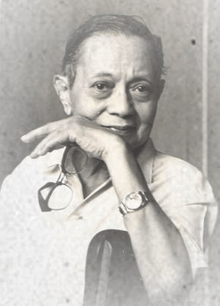 | |
| Born | Fernando Amorsolo y Cueto May 30, 1892 |
| Died | April 24, 1972 (aged 79) |
| Resting place | Loyola Memorial Park,[1] Marikina, Philippines |
| Education | University of the Philippines |
| Known for | Painting |
| Spouse(s) | Salud Tolentino Jorge
( m. 1916; d. 1931)Maria del Carmen (1935–?) |
| Awards | 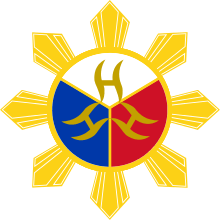 National Artist of the Philippines |
Early life and education
Amorsolo was born on May 30, 1892, in Paco, Manila.[4][5] Don Fabián de la Rosa, his mother's cousin, was also a Filipino painter. At the age of 13, Amorsolo became an apprentice to De la Rosa, who would eventually become the advocate and guide to Amorsolo's painting career. During this time, Amorsolo's mother embroidered to earn money, while Amorsolo helped by selling water color postcards to a local bookstore for 10 centavos each. His brother, Pablo Amorsolo, was also a painter. Amorsolo's first success as a young painter came in 1908, when his painting Leyendo el periódico took second place at the Bazar Escolta, a contest organized by the Asociacion Internacional de Artistas. Between 1909 and 1914, he enrolled at the Art School of the Liceo de Manila.
After graduating from the Liceo, he entered the University of the Philippines' School of Fine Arts, where De la Rosa worked at the time. During college, Fernando Amorsolo's primary influences were the Spanish people court painter Diego Velázquez, John Singer Sargent, Anders Zorn, Claude Monet, Pierre-Auguste Renoir, but mostly his contemporary Spanish masters Joaquín Sorolla Bastida and Ignacio Zuloaga. Amorsolo's most notable work as a student at the Liceo was his painting of a young man and a young woman in a garden, which won him the first prize in the art school exhibition during his graduation year. To make money during school, Amorsolo joined competitions and did illustrations for various Philippine publications, including Severino Reyes’ first novel in Tagalog language, Parusa ng Diyos ("Punishment of God"), Iñigo Ed. Regalado's Madaling Araw ("Dawn"), as well as illustrations for editions of the Pasion. Amorsolo graduated with medals from the University of the Philippines in 1914.
Career
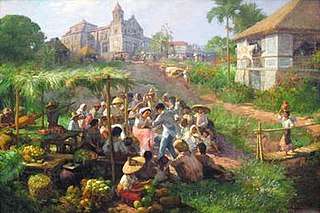
After graduating from the University of the Philippines, Amorsolo worked as a draftsman for the Bureau of Public Works, as a chief artist at the Pacific Commercial Company, and as a part-time instructor at the University of the Philippines (where he would work for 38 years). After three years as an instructor and commercial artist, Amorsolo was given a grant to study at the Academia de San Fernando in Madrid, Spain by Filipino businessman Enrique Zóbel de Ayala. During his seven months in Spain, Amorsolo sketched at museums and along the streets of Madrid, experimenting with the use of light and color. Through the Zóbel grant, Amorsolo was also able to move to New York City, [6] where he encountered postwar impressionism and cubism, which would be major influences on his work.
Amorsolo set up his own studio upon his return to Manila and painted prodigiously during the 1920s and the 1930s. His Rice Planting (1922), which appeared on posters and tourist brochures, became one of the most popular images of the Commonwealth of the Philippines. Beginning in the 1930s, Amorsolo's work was exhibited widely both in the Philippines and abroad. His bright, optimistic, pastoral images set the tone for Philippine painting before World War II. Except for his darker World War II-era paintings, Amorsolo painted quiet and peaceful scenes throughout his career.
Amorsolo was sought after by influential Filipinos including Luis Araneta, Antonio Araneta and Jorge B. Vargas. Amorsolo also became the favourite Philippine artist of United States officials and visitors to the country. Due to his popularity, Amorsolo had to resort to photographing his works and pasted and mounted them in an album. Prospective patrons could then choose from this catalog of his works. Amorsolo did not create exact replicas of his trademark themes; he recreated the paintings by varying some elements.
His works later appeared on the cover and pages of children textbooks, in novels, in commercial designs, in cartoons and illustrations for the Philippine publications such The Independent, Philippine Magazine, Telembang, El Renacimiento Filipino, and Excelsior. He was the director of the University of the Philippine's College of Fine Arts from 1938 to 1952.
During the 1950s until his death in 1972, Amorsolo averaged to finishing 10 paintings a month. However, during his later years, diabetes, cataracts, arthritis, headaches, dizziness and the death of two sons affected the execution of his works. Amorsolo underwent a cataract operation when he was 70 years old, a surgery that did not impede him from drawing and painting.
Amorsolo was a close friend of the Philippine sculptor Guillermo Tolentino, the creator of the Caloocan City monument to the patriot Andrés Bonifacio.
Style and techniques
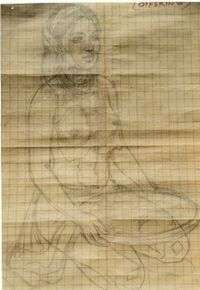
Women and landscapes
Amorsolo is best known for his illuminated landscapes,[7] which often portrayed traditional Filipino customs, culture, fiestas and occupations. His pastoral works presented "an imagined sense of nationhood in counterpoint to American colonial rule" and were important to the formation of Filipino national identity.[2] He was educated in the classical tradition and aimed "to achieve his Philippine version of the Greek ideal for the human form."[8] In his paintings of Filipina women, Amorsolo rejected Western ideals of beauty in favor of Filipino ideals[9] and was fond of basing the faces of his subjects on members of his family.[10]
"[The women I paint should have] a rounded face, not of the oval type often presented to us in newspapers and magazine illustrations. The eyes should be exceptionally lively, not the dreamy, sleepy type that characterizes the Mongolian. The nose should be of the blunt form but firm and strongly marked. ... So the ideal Filipina beauty should not necessarily be white complexioned, nor of the dark brown color of the typical Malayan, but of the clear skin or fresh colored type which we often witness when we met a blushing girl."
— Fernando Amorsolo[9]
Amorsolo used natural light in his paintings and developed the backlighting technique Chiaroscuro, which became his artistic trademark and his greatest contribution to Philippine painting.[3][4][11] In a typical Amorsolo painting, figures are outlined against a characteristic glow, and intense light on one part of the canvas highlights nearby details.[4] Philippine sunlight was a constant feature of Amorsolo's work; he is believed to have painted only one rainy-day scene.[4]
Sketches
Amorsolo was an incessant sketch artist,[9] often drawing sketches at his home, at Luneta Park, and in the countryside.[10] He drew the people he saw around him, from farmers to city-dwellers coping with the Japanese occupation.[9] Amorsolo's impressionistic tendencies, which may be seen in his paintings as well, were at their height in his sketches.[9] His figures were not completely finished but were mere "suggestions" of the image.[9]
Historical paintings and portraits
Amorsolo also painted a series of historical paintings on pre-Colonial and Spanish Colonization events. Amorsolo's Making of the Philippine Flag, in particular, was widely reproduced. His The First Baptism in the Philippines required numerous detailed sketches and colored studies of its elements. These diverse elements were meticulously and carefully set by the artist before being transferred to the final canvas. For his pre-colonial and 16th-century depiction of the Philippines, Amorsolo referred to the written accounts of Antonio Pigafetta, other available reading materials, and visual sources He consulted with the Philippine scholars of the time, H. Pardo de Tavera and Epifanio de los Santos.[12]
Amorsolo also painted oil portraits of Presidents like General Emilio Aguinaldo, and other prominent individuals such as Don Alfredo Jacób and Doña Pura Garchitorena Toral of Camarines Sur. He also painted the wedding picture of Don Mariano Garchitorena and Doña Caridad Pamintuan of Pampanga.
He also did a portrait of American Senator Warren Grant Magnuson (1905–1989), of the Democratic Party from Washington, whom the Warren G. Magnuson Health Sciences Building at the University of Washington, and the Warren G. Magnuson Clinical Center at the National Institutes of Health in Bethesda, Maryland are named after.
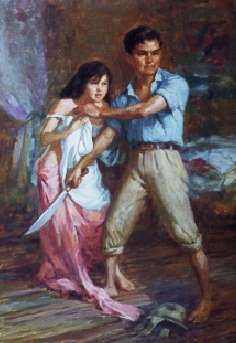
World War II-era works
After the onset of World War II, Amorsolo's typical pastoral scenes were replaced by the depictions of a war-torn nation. During the Japanese occupation of the Philippines during World War II, Amorsolo spent his days at his home near the Japanese garrison, where he sketched war scenes from the house's windows or rooftop.[10]
During the war, he documented the destruction of many landmarks in Manila and the pain, tragedy and death experienced by Filipino people, with his subjects including "women mourning their dead husbands, files of people with pushcarts and makeshift bags leaving a dark burning city tinged with red from fire and blood."[12] Amorsolo frequently portrayed the lives and suffering of Filipina women during World War II. Other World War II-era paintings by Amorsolo include a portrait in absentia of General Douglas MacArthur as well as self-portraits and paintings of Japanese occupation soldiers.[4] In 1948, Amorsolo's wartime paintings were exhibited at the Malacañang Presidential Palace.[4]
Critical evaluation
Amorsolo's supporters consider his portrayals of the countryside as "the true reflections of the Filipino Soul."[8]
Amorsolo has been accused, however, of succumbing to commercialism and merely producing souvenir paintings for American soldiers.[8] Critic Francisco Arcellana wrote in 1948 that Amorsolo's paintings "have nothing to say" and that they were not hard to understand because "there is nothing to understand."[8] Critics have criticized Amorsolo's portraits of Philippine Commonwealth personalities, his large, mid-career anecdotal works, and his large historical paintings.[8] Of the latter, critics have said that his "artistic temperament was simply not suited to generating the sense of dramatic tension necessary for such works."[8]
Another critic, however, while noting that most of Amorsolo's estimated ten thousand works were not worthy of his talent, argues that Amorsolo's oeuvre should nonetheless judged by his best works instead of his worst.[8] Amorsolo's small landscapes, especially those of his early career, have been judged as his best works, "hold[ing] well together plastic-ally."[8] Amorsolo may "be considered a master of the Philippine landscape as landscape, even outranking Luna and Hidalgo who also did some Philippine landscapes of the same measurements."[8]
Death
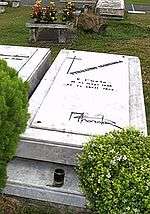
After being confined at the St. Luke's Hospital in Quezon City for two months, Amorsolo died of heart failure at the age of 79 on April 24, 1972.
Legacy
Four days after his death, Amorsolo was honored as the first National Artist in Painting at the Cultural Center of the Philippines by then-President Ferdinand Marcos. The volume of paintings, sketches and studies of Amorsolo is believed to have reached more than 10,000 pieces. Amorsolo was an important influence on contemporary Filipino art and artists, even beyond the so-called "Amorsolo school."[8] Amorsolo's influence can be seen in many landscape paintings by Filipino artists, including early landscape paintings by abstract painter Federico Aguilar Alcuaz.[8]
In 2003, Amorsolo's children founded the Fernando C. Amorsolo Art Foundation, which is dedicated to preserving Fernando Amorsolo's legacy, promoting his style and vision, and preserving a national heritage through the conservation and promotion of his works.[13]
During the post-war period, Insular Life commissioned Amorsolo to create a series of paintings of historical events for their offices (and which were subsequently used in Insular Life calendars from '50s to '80s). .
In Wellesley, Massachusetts, two original 1950s paintings by Amorsolo, The Cockfight and Resting Under the Trees, were bought by a New Jersey collector for $36,000 and $31,500, respectively.[14] During a 2002 episode of Antiques Roadshow, a Sotheby's antiques appraiser estimated that an attendee's signed 1945 rural landscape painting by Amorsolo could fetch between $30,000 and $50,000 at auction.[15] At a 1996 Christie's auction, Amorsolo's The Marketplace went for $174,000.[16] In April 2002, Portrait of Fernanda De Jesus was bought for US$377,947.
On November 30, 2009, the Family Gathering Fruit sold for US$77,257 at Christie's. In December 2009, Fruit Gatherer was auctioned off in Maryland, in record-breaking manner, topping 19th- and 20th-century European and American paintings. In May 2010, the highest priced Amorsolo painting was auctioned off at Christie's for about US$440,000.
Museums
The Jorge B. Vargas Museum and Filipiniana Research Center in Manila displays a major collection of Amorsolo's work.[17]
Major works
Major works by Amorsolo include:[11]
- Babaeng Nagbabasa
- Afternoon Meal of the Workers (Noonday Meal of the Rice Workers) (1939)
- Assassination of Governor Bustamante
- Bataan
- The Bombing of the Intendencia (1942)
- The Building of Intramuros
- Burning of the Idol
- The Burning of Manila (1946)
- El Ciego (1928)
- The Conversion of the Filipinos (1931)
- Corner of Hell
- Dalagang Bukid (1936)
- Defense of a Filipina Woman's Honor (1945)
- La destruccion de Manila por los salvajes japoneses (The Destruction of Manila by the Savage Japanese)
- Early Filipino State Wedding
- Early Sulu Wedding (c. 1955-1960)
- The Explosion (1944)
- The First Baptism in the Philippines (1949)
- The First Mass in the Philippines
- Fruit Gatherer (1950)
- Fruit Pickers Harvesting Under the Mango Tree (1939)
- Maiden in a Stream (1921)
- Making of the Philippine Flag
- Marca Demonio (1917)
- The Mestiza (1943)
- My Wife, Salud (1920; lost in World War II)[18]
- One Casualty
- Our Lady of Light (1950)
- Planting Rice (1946)
- Princess Urduja
- The Rape of Manila (1942)
- Rice Planting (1922)
- Sale of Panay
- Sikatuna
- Sunday Morning Going to Town (1958)
- US Senator Warren Magnuson Oil Portrait (1958)
- Traders
- El violinista (The Violinist)
Awards and achievements
- 1908 – 2nd Prize, Bazar Escolta tea and taki (Asocacion Internacional de Artistas), for Levendo Periodico
- 1922 – 1st Prize, Commercial and Industrial Fair in the Manila Carnival
- 1929 – 1st Prize, New York's World Fair, for Afternoon Meal of Rice Workers (also known as Noonday Meal of the Rice Workers)
- 1940 – Outstanding University of the Philippines Alumnus Award
- 1959 – Gold Medal, UNESCO National Commission
- 1961 – Rizal Pro Patria Award
- 1961 – Honorary Doctorate in the Humanities, from the Far Eastern University
- 1963 – Diploma of Merit from the University of the Philippines
- 1963 – Patnubay ng Sining at Kalinangan Award, from the City of Manila
- 1963 – Republic Cultural Heritage Award
- 1972 – Gawad CCP para sa Sining, from the Cultural Center of the Philippines[11]
In 1972, Fernando Amorsolo became the first Filipino to be distinguished as the Philippine's National Artist in Painting. He was named as the "Grand Old Man of Philippine Art" during the inauguration of the Manila Hilton's art center, where his paintings were exhibited on January 23, 1969.
Major exhibitions
Outside the Philippines, his exhibitions were held in Belgium, at the Exposicion de Panama in 1914, at a one-man show at the Grand Central Art Galleries in New York City in 1925, and at the National Museum in Herran on November 6, 1948. During the 1931 Paris Exposition, Amorsolo exhibited one of his anecdotal paintings, The Conversion of the Filipinos. Amorsolo's entries at the Exposicion in Panama were a portrait of U.S. President Woodrow Wilson and the piece La Muerte de Socrates. At the 1948 National Museum in Herran, Amorsolo exhibition was sponsored by the Art Association of the Philippines. In 1950, Amorsolo exhibited two more historical paintings, Faith Among the Ruins and Baptism of Rajah Humabon at ssthe Missionary Art Exhibit in Rome. In 1979, Fernando Amorsolo's legacy as a painter was celebrated through an exhibition of his works at the Art Center of the Manila Hilton.[7] His art was also featured in a 2007 exhibition in Havana.[19]
Personal life
During his lifetime, Amorsolo was married twice and had 13 children. In 1916, he married Salud Tolentino Jorge, with whom he had six children. Amorsolo's first wife died in 1931 leaving him with six children. He had six more children by a common-law wife, named Virginia Guevarra Santos. Amorsolo have three children with her namely Manuel (followed in his father's footstep, with a degree in Fine Arts from the University of the Philippines), Jorge and Norma when he met his second wife. Subsequently, Virginia found an engagement ring in one of Amorsolo's drawers; she knew about Maria, that prompted her to leave his house with her three children. In 1935, he married Maria del Carmen who gave him eight more children. Among her daughters are Sylvia Amorsolo-Lazo and Luz. But as Maria was giving birth with his children, Virginia had three more children with Amorsolo. His reputation was growing as fast as his brood and his work was more than enough to provide for his rather large family. Six of Amorsolo's children became artists themselves.
See also
- Arts of the Philippines
- Ginebra San Miguel
- José Honorato Lozano
- Juan Luna
- Fabián de la Rosa
- Boxer Codex
- Justiniano Asuncion
References
- "LOOK: Amorsolo statue, other landmarks at Loyola Memorial Park". The Philippine Star. 1 November 2018. Retrieved 8 April 2019.
- Hallman, Tim (August 11, 2006). "Pioneers of Philippine Art: Luna, Amorsolo, Zóbel" (PDF). Asian Art Museum. Archived from the original (PDF) on February 20, 2012. Retrieved October 8, 2016.
- "Fernando C. Amorsolo". National Commission for Culture and the Arts. Archived from the original on March 15, 2008. Retrieved 8 October 2016.
- Gale, Thomson (2005–2006). "Dernando Amorsolo". Encyclopedia of World Biography. Thomson Corporation. Retrieved 8 October 2016.
- Wang, Nickie (13 September 2008). "Introducing Fernando Amorsolo to a new generation". Manila Standard Today. Retrieved 8 October 2016.
- Frank Castle, Castle Fine Arts , expert appraiser on the Antiques Roadshow, PBS , 2005
- "Fernando Amorsolo". Filipinos in History. Manila, Philippines: National Historical Institute. Available for download though nhi.gov.ph Archived 2007-09-27 at the Wayback Machine (requires registration).
- Benesa, Leo. "An Amorsolo Festival" Archived 2007-09-28 at the Wayback Machine (originally from Philippine Sunday Express, November 16, 1975). What is Philippine about Philippine Art? and Other Essays, Manila: National Commission for Culture and the Arts, 2000, pp. 24-27.
- Paras-Perez, Rodriguez (1992). Fernando C. Amorsolo: Drawings. Manila: Lopez Museum. OCLC 702602295.
- Amorsolo Lazo, Sylvia. "Remembering Papa" Archived 2007-07-02 at the Wayback Machine. Lopez Memorial Museum (2003). Retrieved June 30, 2007.
- "Fernando C. Amorsolo (1892-1972)". GlobalPinoy.com. Archived from the original on 19 July 2010. Retrieved 30 June 2007.
- Ocampo, Ambeth. "Amorsolo's Brush with History" Archived 2007-06-21 at the Wayback Machine. Lopez Memorial Museum (2003). Retrieved June 30, 2007.
- "Fernando C. Amorsolo Art Foundation". FernandoAmorsolo.com. Retrieved July 2, 2007.
- "Estate Sale Yields Fine Art, Furniture Gems in Wellesley, Mass." Archived 2007-09-27 at the Wayback Machine Antiques and the Arts online, January 16, 2001. Retrieved on July 2, 2007
- "New Orleans, LA (2002)" (Antiques Roadshow program #619, Morial Convention Center, aired November 11, 2002). PBS.org, retrieved on: July 2, 2007
- Bacani, Cesar (Reported by Steven Poh/Kuala Lumpur, Keith Loveard/Jakarta and Susan Berfield/Hong Kong). "The Fine Art of the Sale: Sotheby's and Christie's are Targeting Southeast Asia," Asiaweek (April 26, 1996), retrieved on: July 2, 2007.
- Cruz, Jasmine (28 January 2015). "The Vargas Museum permanent collection: Amorsolos and more". BusinessWorld. Retrieved 6 September 2016.
- Fernando Amorsolo Seven-Museum Exhibition. CRIBS Foundation, Inc. 2008. p. 25. ISBN 978-971-93896-4-4. Retrieved April 10, 2020.
- "Havana Inaugurates Philippine Modern Exhibit." Philippine Department of Foreign Affairs, March 2, 2007. Retrieved August 1, 2007.
External links
| Wikimedia Commons has media related to Fernando Amorsolo. |
- Fernando C. Amorsolo Art Foundation
- Photographs of Amorsolo's palette, wallet, and other personal effects at flickr.com.
- Amorsolo works at Allinson Gallery.
- Amorsolo works at Frazer Fine Art.
- Amorsolo bio at Geringer Art.
- Amorsolo works at Philippine Consulate San Francisco, California[1]
- "Amorsolo masterpieces now on display at PH post in San Francisco". ABS-CBN news. November 26, 2019.